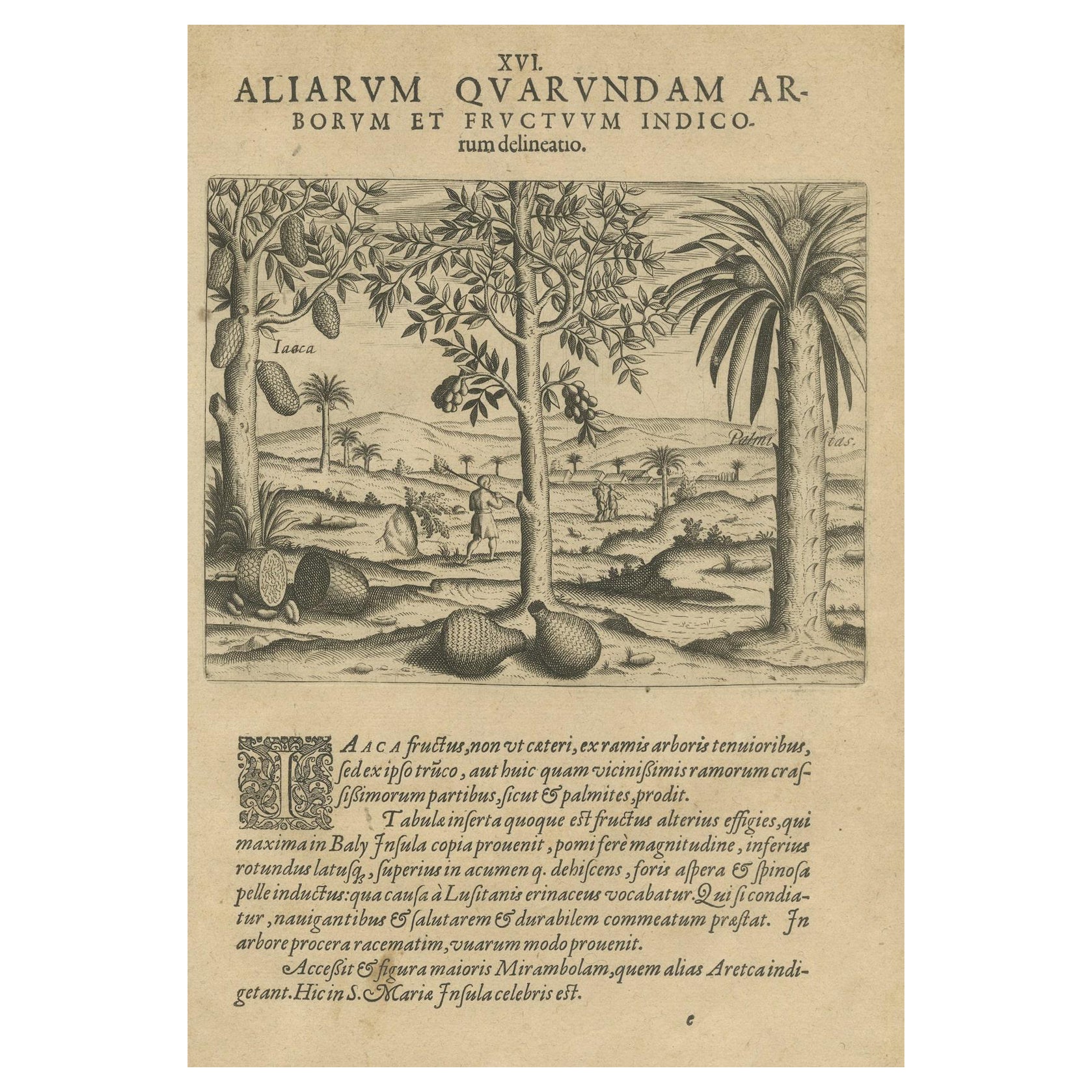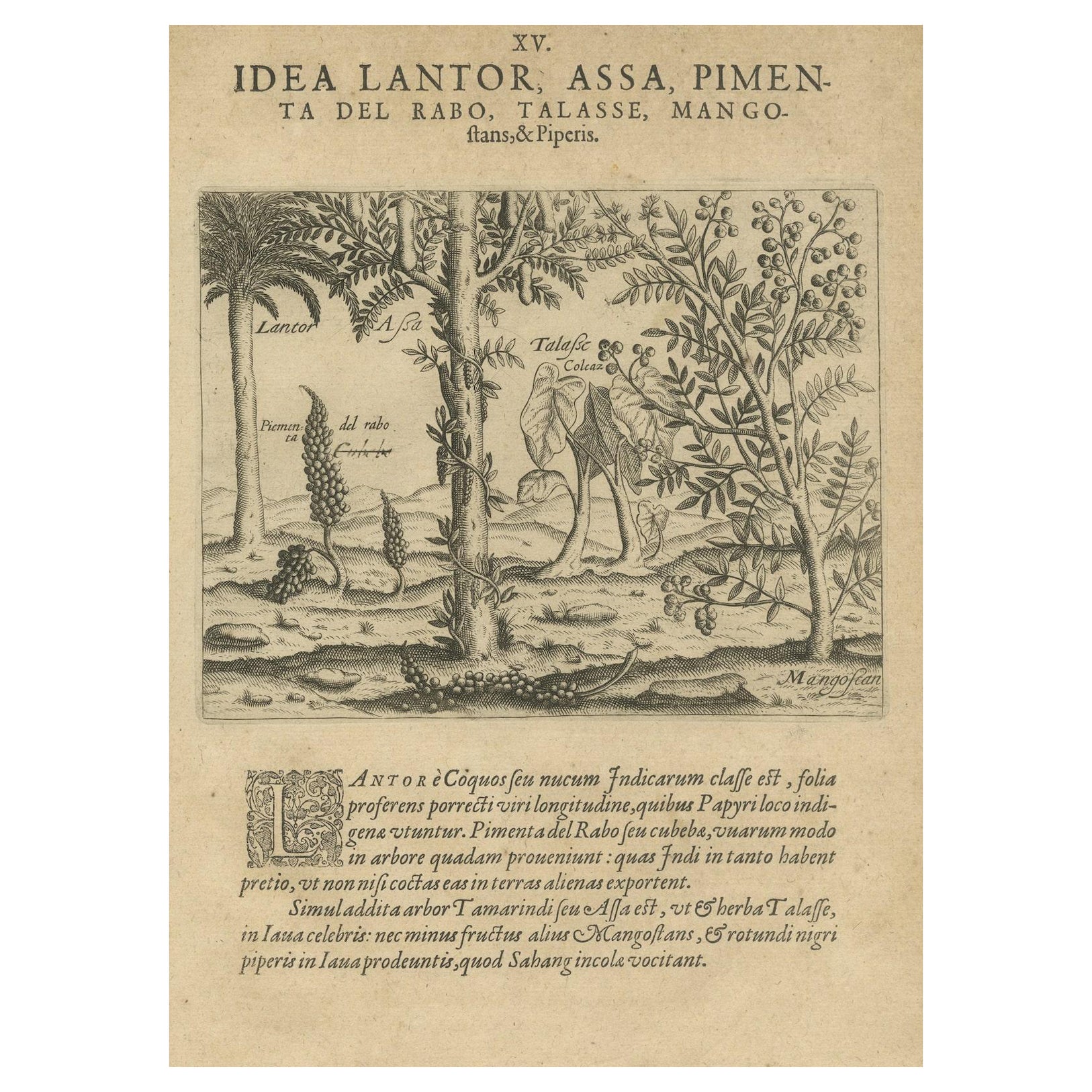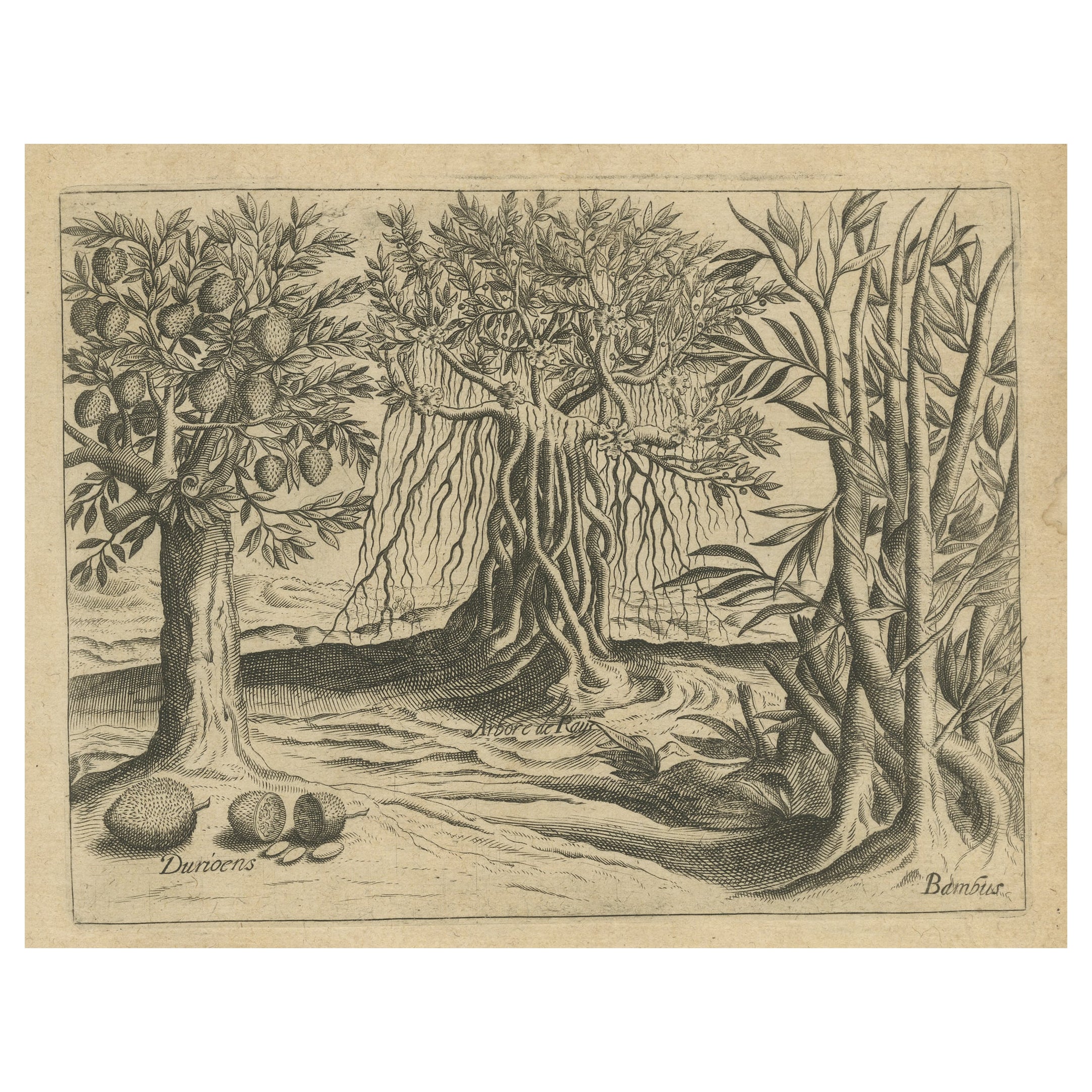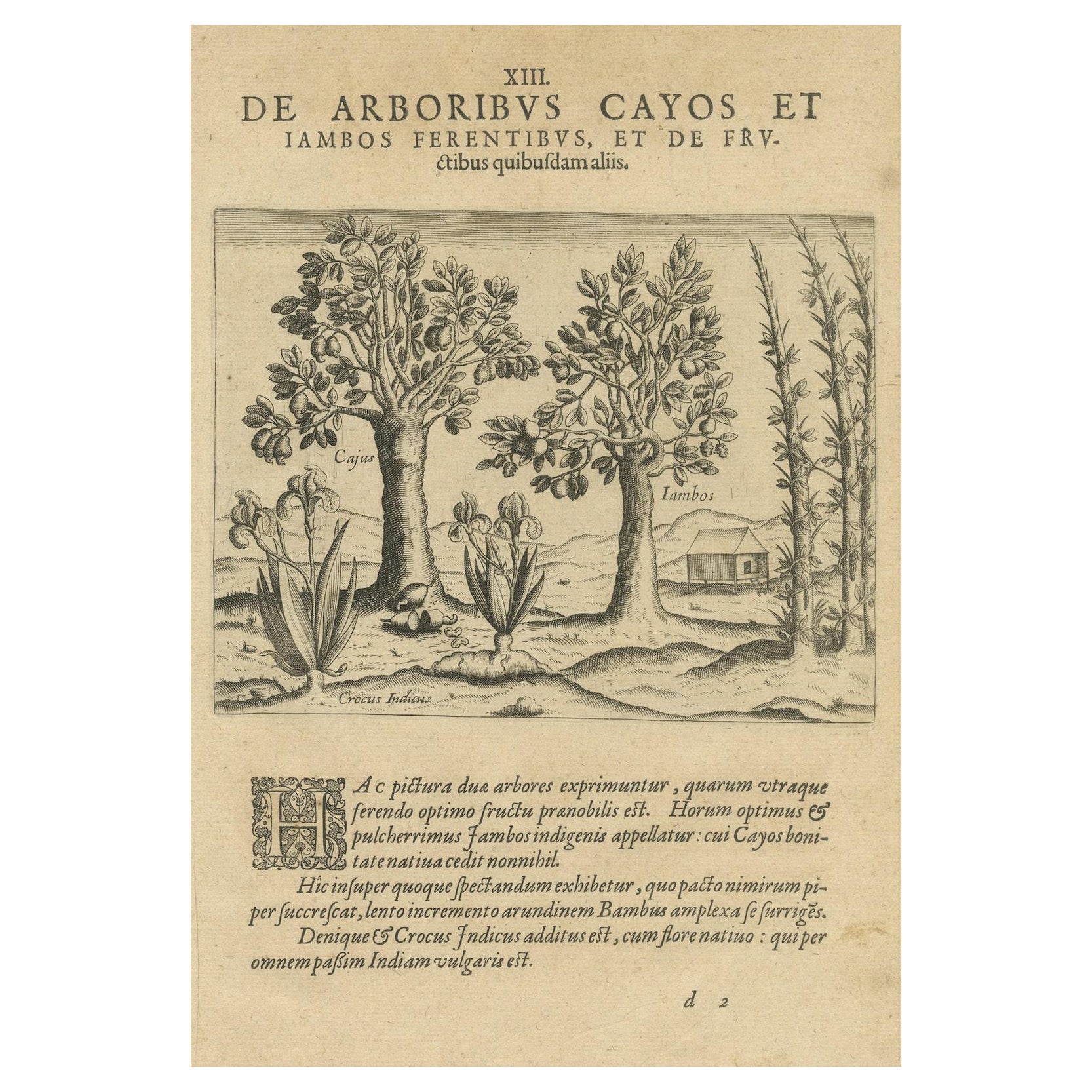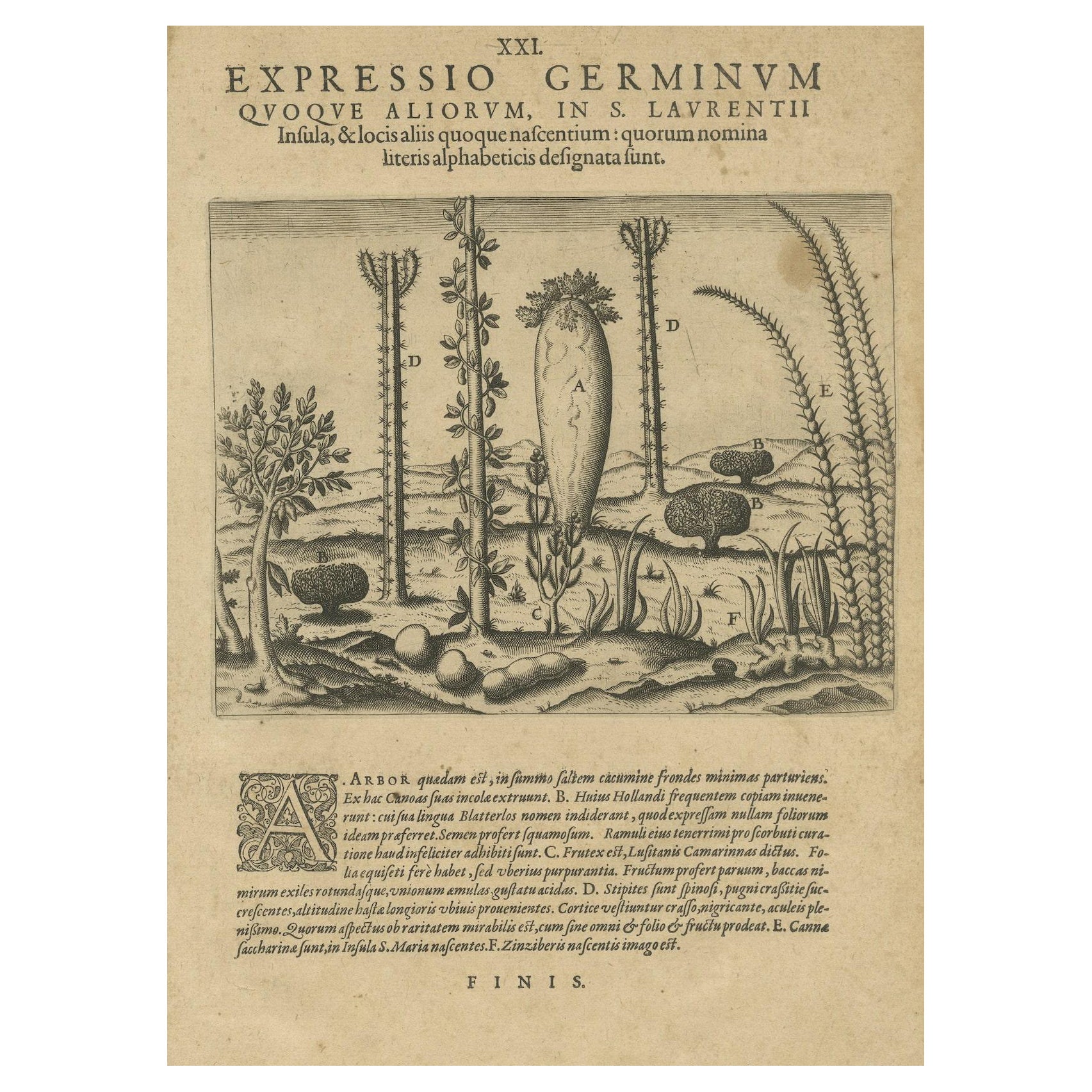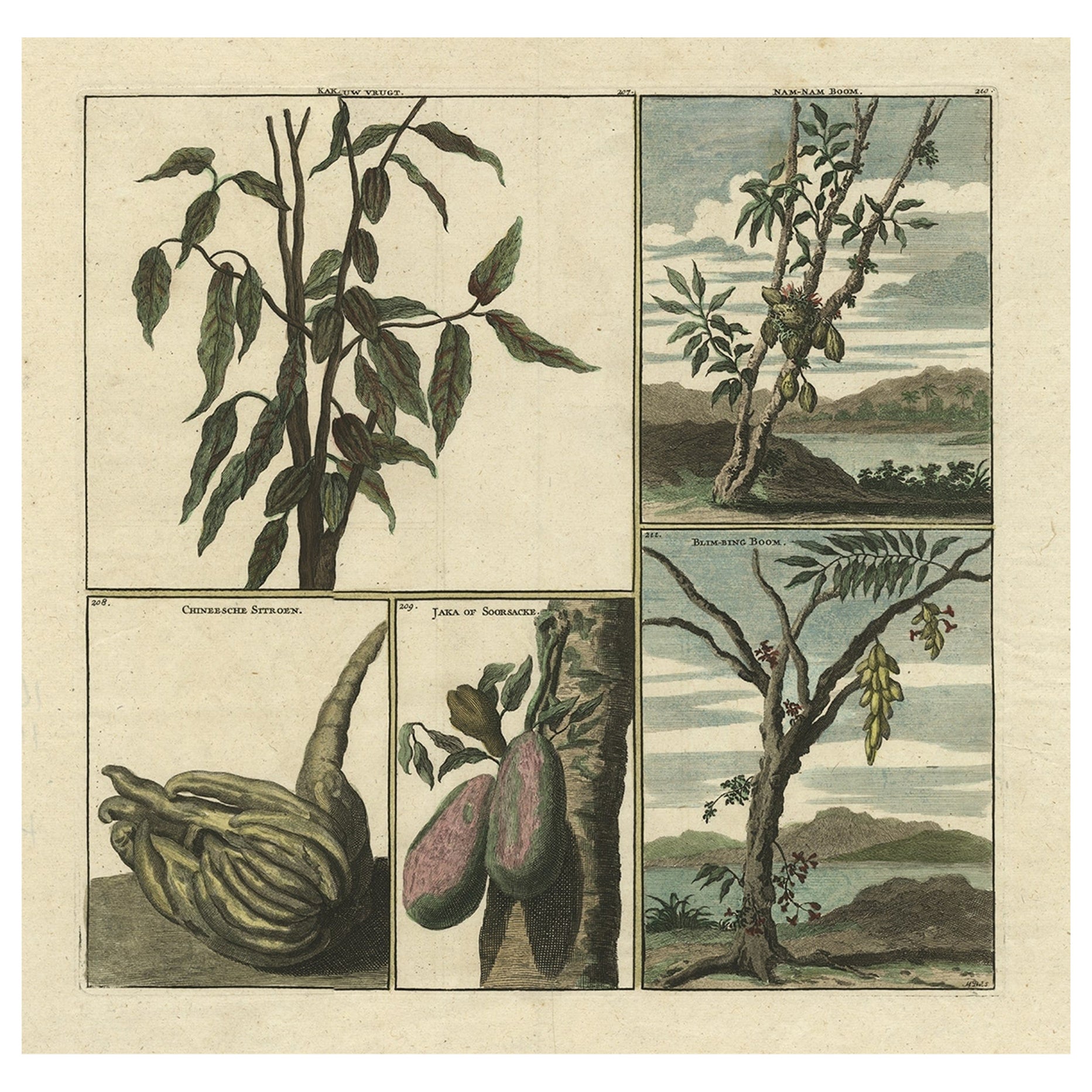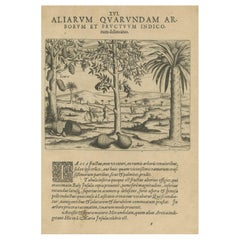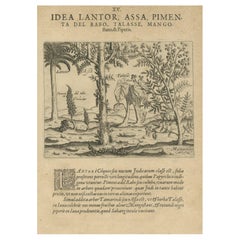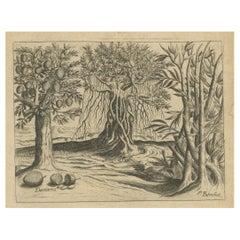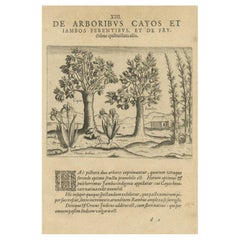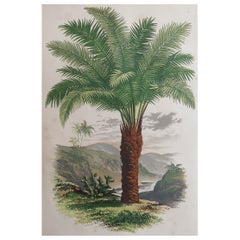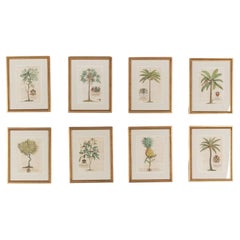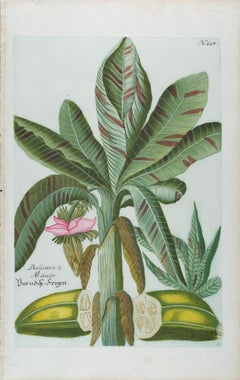Items Similar to Cornucopia of India: Pineapples, Betel, Date Palms, Soursop, and Mangoes, 1601
Want more images or videos?
Request additional images or videos from the seller
1 of 8
Cornucopia of India: Pineapples, Betel, Date Palms, Soursop, and Mangoes, 1601
$519.84
$649.8020% Off
£389.65
£487.0620% Off
€440
€55020% Off
CA$714.17
CA$892.7120% Off
A$797.30
A$996.6320% Off
CHF 417.78
CHF 522.2220% Off
MX$9,759.79
MX$12,199.7320% Off
NOK 5,305.75
NOK 6,632.1920% Off
SEK 5,002.65
SEK 6,253.3120% Off
DKK 3,349.44
DKK 4,186.8020% Off
About the Item
Title: "Cornucopia of India: Pineapples, Betel, Date Palms, Soursop, and Mangoes in De Bry's 1601 Engraving"
Description: This 1601 engraving by Theodore de Bry displays a rich array of Indian fruits and plants, highlighting the tropical abundance discovered by Europeans during the exploration of the East Indies. Prominently featured are pineapples (Ananas), a symbol of exotic luxury in the period; betel plants (Betle), whose leaves were valued for their use in traditional chewing mixtures; date palms (Palma dactylifera), with their sweet fruits; soursop trees (Samaca), known for their distinctive, spiky fruit; and mango trees (Mangos), heavy with ripe fruit.
De Bry's work captures the botanical diversity with a remarkable fidelity to detail, reflecting the curiosity and wonder of the European Renaissance towards the natural world. These plants were not only sources of food but also held economic and medicinal importance in the regions from which they originated.
Translation of the Latin text:
"All the fruits of India are very pleasing and useful, among which the Pineapple surpasses the others in taste and aroma, as it has been previously described.
Moreover, the image of the Betel is added, that at least it can be distinguished by the form of its leaves, which are sprinkled in the manner of pepper and thus rise higher; from which they can be discerned with difficulty by their likeness to the earth. The leaves of Betel are very useful, which the Indians chew almost constantly, especially when mixed with the fruit of the Areca, as the story more plainly sets forth."
The engraving is a page from Part IV of de Bry's "Petits Voyages," which narrates significant expeditions to the East Indies, including those led by Jan Juygen van Linschoten and Cornelis de Houtman between 1595-97, as well as the journey by Jacob van Neck and Wybrandt van Warwijck in 1598-99. These works were not merely artistic endeavors but also ethnographic records, showcasing indigenous peoples, fauna, flora, and the diverse riches of lands like India, Madagascar, and the East Indies.
Though Theodore de Bry began this ambitious project, it was continued posthumously by his family and later completed by his son-in-law, Matthaus Merian, in 1644. This particular engraving, rich in detail and drama, offers a window into the perilous and wondrous experiences of early explorers, and the ways in which these moments were captured and communicated to a European audience hungry for knowledge of the wider world.
- Dimensions:Height: 11.82 in (30 cm)Width: 7.88 in (20 cm)Depth: 0 in (0.02 mm)
- Materials and Techniques:Paper,Engraved
- Period:Early 17th Century
- Date of Manufacture:1601
- Condition:The condition of the print is very good, considering its age of over 400 years. Light brownish toning and some soiling due to handling, mainly around the edges. Please study this image carefully.
- Seller Location:Langweer, NL
- Reference Number:Seller: BG-13596-161stDibs: LU3054337756272
About the Seller
5.0
Recognized Seller
These prestigious sellers are industry leaders and represent the highest echelon for item quality and design.
Platinum Seller
Premium sellers with a 4.7+ rating and 24-hour response times
Established in 2009
1stDibs seller since 2017
2,513 sales on 1stDibs
Typical response time: <1 hour
- ShippingRetrieving quote...Shipping from: Langweer, Netherlands
- Return Policy
Authenticity Guarantee
In the unlikely event there’s an issue with an item’s authenticity, contact us within 1 year for a full refund. DetailsMoney-Back Guarantee
If your item is not as described, is damaged in transit, or does not arrive, contact us within 7 days for a full refund. Details24-Hour Cancellation
You have a 24-hour grace period in which to reconsider your purchase, with no questions asked.Vetted Professional Sellers
Our world-class sellers must adhere to strict standards for service and quality, maintaining the integrity of our listings.Price-Match Guarantee
If you find that a seller listed the same item for a lower price elsewhere, we’ll match it.Trusted Global Delivery
Our best-in-class carrier network provides specialized shipping options worldwide, including custom delivery.More From This Seller
View AllTropical Abundance: The Jackfruit and Palm Trees in De Bry's 1601 Engraving
Located in Langweer, NL
"Tropical Abundance: The Jackfruit and Palm Trees in De Bry's 1601 Engraving"
Description: This remarkable 1601 engraving by Theodore de Bry illustrates the lush vegetation of India...
Category
Antique Early 17th Century Prints
Materials
Paper
$519 Sale Price
20% Off
Verdant Wonders: Exotic Trees and Spices of India in De Bry's 1601 Illustration
Located in Langweer, NL
Title: "Verdant Wonders: Exotic Trees and Spices of India in De Bry's 1601 Illustration"
Description: This striking 1601 engraving by Theodore de Bry, titled "IDEA LANTOR, ASSA, PIM...
Category
Antique Early 17th Century Prints
Materials
Paper
$519 Sale Price
20% Off
Botanical Marvels of India: Bamboo and Durian in De Bry's 1601 Copper Engraving
Located in Langweer, NL
This 1601 engraving by Theodore de Bry, a master engraver and publisher of the late Renaissance period, depicts the flora of India with a remarkable degree of detail and artistry. The print is titled "DE ALGA SEV ARVNDINE INDICA, BAMBVS DICTA, ITEM DE arbore radicosa: & tandem de arbore Duryeons," which translates to "About the Seaweed or Reed of India, called Bamboo, also about the root tree: and finally about the Duryeons tree."
In the illustration, we see a lush depiction of a bamboo grove, with its characteristic tall and slender form, showcasing the plant's extensive root system and dense foliage. To the left, there is a tree bearing large, round fruits, likely the durian, labeled here as "Duryeons." The durian is known for its distinctive size, unique aroma, and spiky husk. The image captures both the exotic appeal and the utilitarian value of these plants, which were of great interest to European audiences unfamiliar with such tropical vegetation.
The visual composition conveys the tropical abundance and biodiversity of the Indian subcontinent. De Bry's engravings like this were highly sought after in Europe for their exotic subject matter and served to educate and fascinate the European public about the natural wonders of the world beyond their borders. As a historical document, this engraving provides insight into the botanical knowledge and the artistic conventions of the period, making it a valuable piece for both its historical significance and its aesthetic beauty.
De Bry's work is renowned for its attention to detail, and this print is a testament to his ability to capture the essence of exotic lands and their natural abundance. His engravings were among the first visual records to reach Europe from the New World and the East, fueling curiosity and fascination with distant lands. This particular piece is not only a work of art but also a historical document, offering insight into the botanical wealth of India as seen through the eyes of early modern Europeans...
Category
Antique Early 17th Century Prints
Materials
Paper
$519 Sale Price
20% Off
Exotic Flora of the Indies: The Cajus and Jambos Trees Copper Engraved in 1601
Located in Langweer, NL
Title: "Exotic Flora of the Indies: The Cajus and Jambos Trees in De Bry's 1601 Engraving"
Description: This detailed engraving by Theodore de Bry, dating back to 1601, beautifully illustrates two tropical trees, the Cajus and the Jambos, both renowned for their delectable fruits in the regions of India. The Cajus tree, likely referring to what is known today as the cashew, is depicted with its distinctive fruit that dangles below the swollen pedicel, commonly called the cashew apple. The Jambos tree, with its lush, dense foliage and abundant fruiting, could be related to the rose apple, known for its fragrant, rose-scented fruit.
Included in the scene is a depiction of the Indian Crocus, adding a touch of the diverse understory vegetation of the tropical climate. The image conveys a peaceful coexistence with nature, as indicated by a modest dwelling in the background, suggesting the integration of these trees into the daily lives of the local inhabitants for both nourishment and commerce.
The text is in Latin, and here is the English translation:
"In this picture, two trees are shown, each of which bears the most excellent and noble fruit. The best of these is called the Jambos, native to the region, which the inhabitants call Cayos. On this tree, nothing of note is bestowed.
Moreover, this also represents a marvelous spectacle, in which the slow-growing cane bamboo surrounds itself. Finally, the Indian Crocus has been added, which blooms with its native flower; which is widespread throughout all of India."
De Bry's engravings were pivotal in bringing the natural wealth of the New World and the East Indies to the European imagination. His work not only served as an artistic endeavor but also as an educational tool that fed the European appetite for knowledge about the vast diversity of the world's flora and fauna. This engraving, with its precision and attention to botanical detail, remains a significant historical record of the natural world as seen through the lens of the early modern European...
Category
Antique Early 17th Century Prints
Materials
Paper
$519 Sale Price
20% Off
Botanical Illustration of Saint Lawrence's (Madagascar) Seeds and Plants, 1601
Located in Langweer, NL
"Botanical Illustration of Saint Lawrence's Seeds and Plants by De Bry, 1601"
Description: This engraving from Theodore de Bry's collection, produced in 1601, features a botanical study of various seeds and plants native to the island of Saint Lawrence, also known as Madagascar. Each plant is meticulously rendered with Latin letters corresponding to a legend that identifies them. This careful study was part of De Bry’s extensive work to document and illustrate the flora and fauna encountered by European explorers during their voyages to exotic lands.
The illustration captures the diverse plant life from the island, from the bulbous shapes of the roots in the foreground to the towering forms of the trees in the background. The detail in the image reflects the European fascination with new and foreign natural history, a subject that was growing in popularity and significance during the Age of Exploration. De Bry's works served not only as scientific records but also as means to captivate and educate his contemporaries about the wonders of the natural world.
Translation of the Latin text:
"There is a certain tree, its summit dividing into the smallest of branches. From this, the Chaonas nuts are collected. B. The House of...
Category
Antique Early 17th Century Prints
Materials
Paper
$482 Sale Price
20% Off
Old Print with Fruits from Asia Cocoa, Soursop Belimbing, Chinese Lemon, 1711
Located in Langweer, NL
Antique print titled 'Kakauw Vrugt - Nam nam Boom - Chineesche Sitroen - Jaka of Soursacke - Blim bing Boom'.
Original antique print showing several fruits from Asia; Cacao, Cynometra cauliflora or Namu-namu, Chinese lemon, Soursop and Averrhoa bilimbi (commonly known as bilimbi, cucumber tree, or tree sorrel). This print originates from 'Cornelis de Bruins...
Category
Antique 1710s Prints
Materials
Paper
$340 Sale Price
20% Off
You May Also Like
Original Antique Print of A Palm Tree, circa 1870
Located in St Annes, Lancashire
Lovely print of a palm tree
Chromo-lithograph
Original color
Published, circa 1870
Unframed.
Free shipping
Category
Antique 1870s English Victorian Prints
Materials
Paper
Set of Eight 18th Century Tropical Palm Tree and Plant Prints
By Georg Dionysius Ehret
Located in Gloucestershire, GB
Set of eight 18th Century tropical palm tree and plant prints. From a selection of Georg Dionysius Ehret hand-coloured engravings depicting local flora of Barbados.
Each is dedicat...
Category
Antique 18th Century German Prints
Materials
Wood, Paper
Pair of 17th Century Pineapple Engravings
Located in Hawthorne, CA
Artist unknown for this pair of pineapple paintings from 17th century. Beautifully gilt-framed and matted.
Category
Antique 17th Century American Modern Drawings
Materials
Paper
$3,900 Sale Price / set
40% Off
Banana Plant: An 18th Century Hand-colored Botanical Engraving by J. Weinmann
By Johann Wilhelm Weinmann
Located in Alamo, CA
This is an original antique colored botanical mezzotint and line engraving of banana plants, which is finished with hand-coloring. It is entitled "Banana 2. Mauze, Baradis-feigen", p...
Category
Mid-18th Century Naturalistic Still-life Prints
Materials
Engraving, Mezzotint
Pineapple with foliage.
By Maria Sibylla Merian
Located in London, GB
[MERIAN, Maria Sibyl].
Pineapple with foliage.
The Hague, Gosse, 1719.
Engraving of a Pineapple with foliage by J. Mulder, P. Sluyter and D. Stoopendaal after Merian, with later hand-colour, from Dissertatio de Generatione et Metamorphasibus Insectorum Surinamensium. Framed and glazed, overall dimensions: 40cm by 53.2cm by 4.5cm.
Superb engravings which depict the metamorphoses of South American insects and the exotic plants on which they feed.
Maria Sybilla, daughter of the German engraver and publisher Matthias Merian, devoted herself to the study of European insects and their metamorphoses. As a result of the wealth of tropical varieties being brought back by the Dutch West Indies Company...
Category
1710s Naturalistic Still-life Prints
Materials
Watercolor, Handmade Paper, Engraving
Pineapple Engraving
By Johann Wilhelm Weinmann
Located in New York, NY
Original engraving by Johann Wilhelm Weinmann from "Phytanthosa Iconographia." Ratisbon, 1737-1745.
This plate: No. 113 Ananas Folio Latiore.
Mezzotint engraving printed in color and...
Category
Early 18th Century Prints and Multiples
Materials
Laid Paper
More Ways To Browse
Spanish Colonial Plates
Specimen Chest
Steel Guitar
Syria Jewelry
Tall Mid Century Modern Buffet
Tall Narrow Shelves
Tamil Nadu
Terracotta Sink
Thai Bamboo
Thai Dragons
Thai Statue Wood
Tibetan Buddha Statue
Tiffany Glass Mirror
Tin Horse
Tubular Chrome Shelf
Unglazed Clay Jar
Used Metal Storage Bins
Vaseline Uranium Glass
